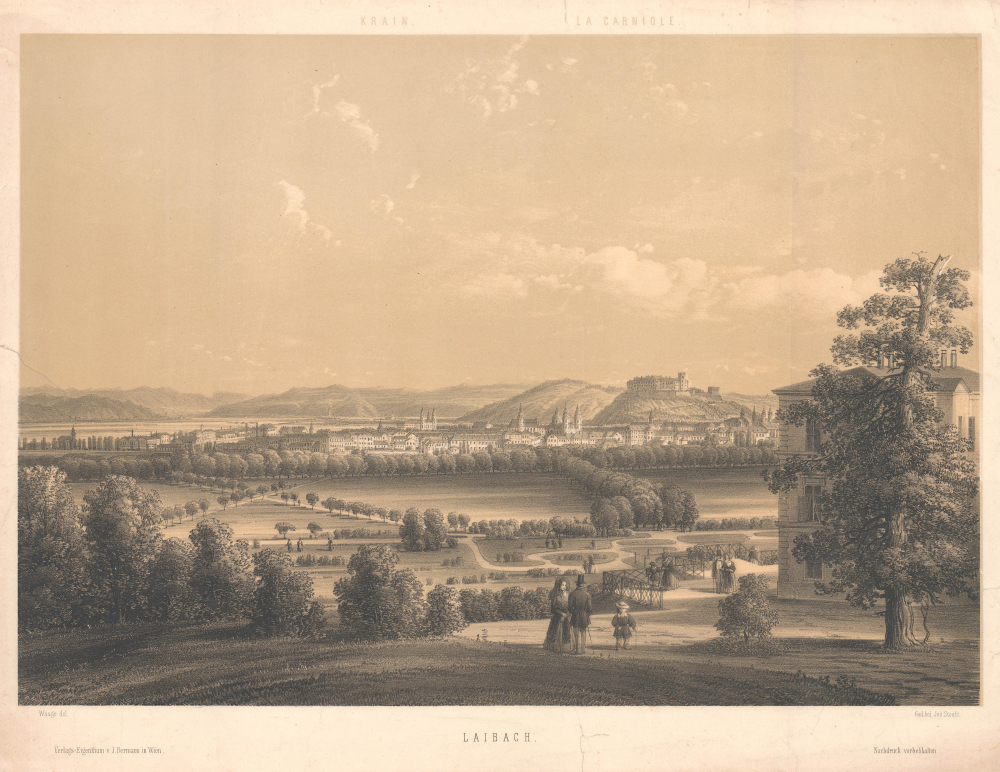1850 Waage View of Ljubljana, Slovenia
LaibachLjubljana-waage-1850
Title
1850 (undated) 16 x 20.5 in (40.64 x 52.07 cm)
Description
A Closer Look
The view looks roughly south on Ljubljana from a garden to the north, thus placing Ljubljana Castle on the right in the background. The Ljublijanica River, which runs through the center of town, is obscured by buildings, including several large churches. In the foreground, well-dressed families stroll through a formal garden.Chromolithography
Chromolithography, sometimes called oleography, is a color lithographic technique developed in the mid-19th century. The process uses multiple lithographic stones, one for each color, to yield a rich composite effect. Generally, a chromolithograph begins with a black basecoat upon which subsequent colors are layered. Some chromolithographs used 30 or more separate lithographic stones to achieve the desired effect. Chromolithograph color can be blended for even more dramatic results. The process became popular in the late 19th and early 20th centuries when it emerged as the dominant method of color printing. The vivid color chromolithography made it exceptionally effective for advertising and propaganda.Publication History and Census
This view was drawn by Karl Waage around 1840 and committed to lithographic stone in Vienna by Josef Stoufs. It was issued for Josef Bermann's Ansichten der österreichischen Monarchie.CartographerS
Karl Waage (Karl Waagen, Carl Waage; September 5, 1820 - 1885) was an Austrian artist, draftsman, and lithographer active in the second half of the 19th century. Waage was born in Dalovice, Western Bohemia (Czech), then part of the Austrian Empire. He specialized in landscapes and portraits, for his work is highly regarded for its technical precision while at the same time criticized for being 'too' realistic and thus lacking idealism. He should not be confused with Carl Waagen (1800 - 1873) of Hamburg, the younger brother of art historian Gustav Friedrich Waagen (1794 - 1868). More by this mapmaker...
Josef Bermann (1810 - July 4, 1886) was a printer, publisher, photographer, and art dealer located in Vienna, Austria. His is the son of the Westphalian art and antique dealer Jeremiah Bermann (1770 - January 2, 1855), from whom he received his professional training. He became a partner in his father's business in 1836, when it was renamed 'Bermann et Fils', and took over fully in 1847. He did not personally participate in the Spring Revolutions of 1848, but was acquainted with many of the leading revolutionaries. He specialized in sheet music, games, art, and numismatics. From 1861 to 1886 he also worked as secretary of the Corporation of Viennese Book, Art and Music Dealers. Learn More...
Josef Stoufs (Joseph Stoufs; fl. c. 1840 - 1870) was an Austrian printer and engraver active in Vienna in the second half of the 19th century. He worked primarily in steel plate engravings and later lithographic stone. He has several patents in the late 1850s regarding novel lithographic printing techniques, including chromolithography. Learn More...

